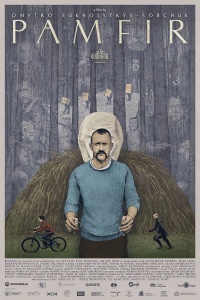A tale of a man tougher than stone: Reviewing the film “Pamfir”3 min read
“Pamfir shows us who we really are. With whom those who cannot take the small village of Chornobaivka deal, and why the mentality of the people is so strong and free-loving that one person is worth ten or more.” This is how director Dmytro Sukholytkyy-Sobchuk described his debut feature, which was screened as part of the Film Confrontations 2022 festival in Warsaw.
The film follows Leonid (Oleksandr Yatsentyuk), a middle-aged man who, after years of hardship and of committing illegal activities to support his family, has abandoned his notorious nickname Pamfir and tries to live peacefully, in compliance with the letter of the law. Taking a break from work in Poland, Leonid returns to his Ukrainian village so he can accompany his family with preparations for Malanka — a vibrant New Year’s celebration popular in the territories of Bukovina. Leonid does not mean to stay — his sole intention is just to spend some time with his loving wife and adolescent son. The story begins to gain momentum when his son, frustrated and resentful about his father’s constant absence, decides to set a local church on fire. Things get severely complicated when it turns out that during Leonid’s absence the church was taken over by a new owner — a ruthless businessman, ruling the village and its surroundings with an iron fist. Faced with the obligation to settle the debt, Leonid opts for the quickest way to make easy cash. Breaking a promise made to his wife years ago, he once again becomes the tough, fearless Pamfir, famous for his numerous successful smuggling escapades through the woods. But he cannot avoid paying a heavy price for this decision. A visible crime of disrupting the new order established by a clique of opportunist cronies leads to punishment, and suddenly Leonid finds himself locked in a prison of local dependencies that is impossible to escape.
The movie presents its own, unique cinematic aesthetics, alluding to a rich tradition.Fascinated by the legacy of the Polish School of Posters, the director asked Polish artist Piotr Gruszczyński to make the poster for his film, resulting in a piece of art resembling posters for Andrei Tarkovsky features.
Furthermore, the director wanted his film to depict the ambiguity and symbolism characteristic in the art of Hieronymus Bosch. He was able to express this by setting his film on the Ukrainian-Romanian border, where the locality is created by morally distorted individuals, a vibrant Hutsul dialect, and picturesque cultural traditions. Yet, the story can be perceived as universal for the entirety of Ukraine, taking into account recurring topics of the Russian war or the tough economic conditions that make people, who are consistently abused by local nouveau riche businessmen, look for a job abroad. The character of Leonid — proud, dedicated and tenacious — appears as a light in the tunnel of this brutal and depressing reality. His actions remind us that despite committed mistakes, one can still choose the right side of the barricade — even when the battle against the odds seems to be lost.
Sukholytkyy-Sobchuk’s debut is a deeply unsettling but rewarding journey of skillfully written characters navigating a rough, gritty, and naturalistic environment. It could be argued that the director wasn’t able to balance the plot well enough to avoid overusing the typical tropes of Eastern European Cinema, such as overrepresenting violence or helplessness against a flawed system. However, it’s worth noting that the characters he’s created act very convincingly given the circumstances, so there’s little to be disappointed about. The movie’s strengths far outweigh its weaknesses, which has been recognised by audiences at numerous international film festivals. Since being nominated for the Caméra d’Or at Cannes, Pamfir has been screened at 40 different festivals, picking up a total of 17 wins and 21 nominations. That shouldn’t surprise anyone, as it’s a clear demonstration of Sukholytkyy-Sobchuk’s natural, raw talent. He has created a work with a compelling, coherent story, strong characters, and a resonant message in a film that is both universal and inextricably Ukrainian.




